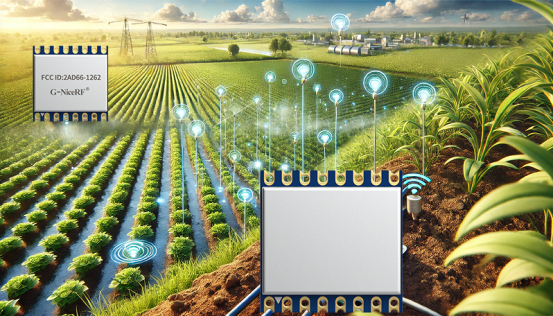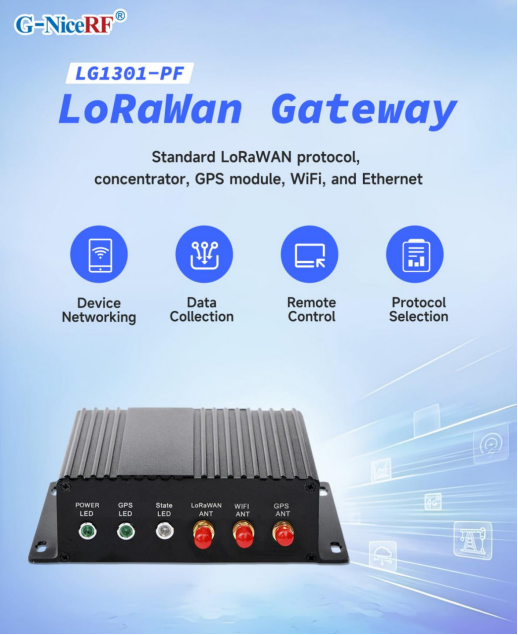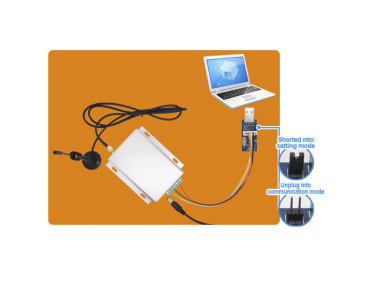Data Security and Precision Control: Precision Application of Smart Irrigation Using LoRa Technology and LoRaWAN Gateway
The application characteristics of LoRa modules in smart irrigation technology are mainly reflected in the following aspects:
Low Power Consumption: LoRa modules are characterized by extremely low power consumption, enabling devices to operate for extended periods on battery power. This reduces the hassle of frequent battery replacements and enhances the system's lifespan and reliability.
Anti-Interference Capability: LoRa technology has excellent anti-interference capabilities., ensuring stable communication quality even in environments with multiple radio signals.
Long-Distance Transmission: Utilizing low-frequency transmission, spread spectrum technology, and high-sensitivity receivers, LoRa modules can achieve wireless communication over distances ranging from several kilometers to over ten kilometers.
MESH Self-Organizing Network: LoRa modules can establish communication connections through self-organizing networks, eliminating the need for complex infrastructure and network wiring.
Precision Irrigation: LoRa modules offer stable and accurate data transmission, enabling real-time delivery of information such as soil moisture and weather conditions.
High Penetration: LoRa technology boasts strong signal penetration and stability, ensuring reliable signal transmission even in complex environments.
Multi-Node Support: LoRa modules support applications with multiple nodes. A single LoRa gateway can connect multiple sensor nodes, forming a complete network system for extensive, multi-point monitoring and management.
Data Security: LoRa modules provide high data security, employing encryption technology to protect data during transmission, preventing data theft or tampering, and ensuring the confidentiality and integrity of agricultural data.
Wide Coverage: LoRa technology can achieve wide coverage, typically ranging from several kilometers to over ten kilometers, without the repeaters.
Module Compatibility: LoRa modules are compatible with various types of sensors and control devices, offering a high level of system integration and facilitating seamless cooperation among different devices.
How the LoRa modules achieve precision irrigation in smart irrigation?
Remote Monitoring: Using LoRa modules, the irrigation system can achieve remote monitoring and control. Users can access real-time environmental data such as soil moisture and temperature from a distance and remotely control irrigation equipment, enabling precision irrigation.
Data Analysis: After the cloud platform receives sensor data, it analyzes and processes the information to promptly understand soil moisture conditions, providing a scientific basis for irrigation decisions.
Remote Control of Equipment: LoRa modules transmit commands to various irrigation nodes through long-distance, low-power wireless communication, controlling valve switches, irrigation times, and irrigation amounts.
Timed Irrigation: The irrigation schedule can be preset, and the LoRa module can be used to control the irrigation equipment to irrigate at the best time.
Feedback Mechanism: After irrigation is completed, the system re-monitors soil conditions and feeds the data back to the central control system.
Functions of the LoRaWAN Gateway LG1301-PF in Smart Irrigation Systems
Features of the LG1301-PF Gateway
LG1301-PF is the LoRaWAN gateway. It can work with any LoRaWAN node which comply Standard LoRaWAN protocol V1.0.
The gateway use linux platform as host.It mainly consists of concentrator ,GPS module ,WIFI and Ethernet. The GPS module send NMEA frames containing time and geographical coordinates data to the host. The GPS module also output one pulse to the sx1301 per second.
The gateway receives the RF data from nodes and sends it to the server. It also receive data from the server and transmit to the nodes. The gateway connects to the server via Ethernet or WiFi.
Support for LoRaWAN Protocol: Adapts to the LoRaWAN protocol, enabling the device to communicate with standard LoRaWAN networks for remote data transmission and management.
UART Interface: Provides a UART interface for convenient data exchange and integration with other devices or sensors.
AES128 Encryption: Uses the AES128 encryption algorithm to ensure the security and privacy of data transmission.
8-Channel Simultaneous Communication: Supports up to 8 channels of communication simultaneously
Configurable Parameters: Users can flexibly configure various parameters according to specific application needs.
Global Positioning System Support: GPS functionality enables precise positioning and tracking of the device.
Remote Transmission: Supports remote data transmission, allowing real-time data transfer and management between the device and the cloud via an internet connection.
Frequency Band Support: Covers multiple frequency bands (such as EU433M, EU868M, KR920M, AS923M, CN780M, CN470M, US915M, AS915M, etc.).
By using NiceRF LoRa gateway devices, sensor equipment in the irrigation field (such as temperature sensors, humidity sensors, light sensors, CO2 sensors, etc.) can be connected in real-time. These sensors collect data in real-time and periodically upload it to the cloud platform or local host computer via LoRa modules. This setup enables remote monitoring, fault alarms, equipment management, and provides scientific and reliable data support for adjusting irrigation strategies.
Data Monitoring Function: The sensor equipment monitors data such as air temperature, air humidity, CO2 levels, light intensity, soil moisture, and soil temperature. This data is transmitted through the LoRa gateway to the cloud platform, allowing users to analyze and process the information conveniently.
Remote Control and Adjustment: The LoRa gateway can connect to irrigation equipment, enabling remote control of the irrigation system. By sending commands from the cloud platform to the LoRa gateway, users can adjust irrigation equipment, such as remotely starting or stopping the equipment or adjusting irrigation parameters. This allows for intelligent irrigation based on feedback from soil moisture sensors, providing precise water management, reducing waste, and improving irrigation efficiency.
Anomaly Alarms and Warnings: The LoRa gateway can monitor abnormal conditions in the farmland environment and send alarm messages to users through the cloud platform. For instance, if soil moisture levels are too low or too high, the LoRa gateway can promptly issue an alert, reminding farmers to take appropriate irrigation measures.
Energy Efficiency Optimization: The gateway is designed with low power consumption features. By optimizing energy management and data transmission frequency, it effectively extends the operating time of the equipment, reduces energy costs, and enhances system sustainability.
 +86-755-23080616
+86-755-23080616
 sales@nicerf.com
sales@nicerf.com
Website: https://www.nicerf.com/
Address: 309-314, 3/F, Bldg A, Hongdu business building, Zone 43, Baoan Dist, Shenzhen, China


 English
English









